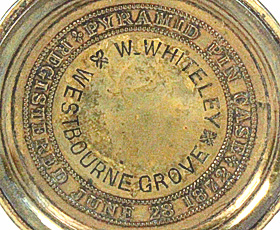Pyramid Pin Case

Needle Case

Design Representation
Design Details
Needle Case Type: |
Figural |
Patent/Registered to: |
W. Avery & Son - Redditch |
Patent/Design Representation #: |
Non-Ornamental Useful: #5367 |
Patent/Design Registration Date: |
June 28, 1872 |
Location of Patent/Design Registration: |
The National Archives (TNA) - Kew, UK |
Reference #: |
TNA Representation - BT 45/27/5367 |
Dimensions: |
4.8 diameter x 6 |
Material: |
Brass |
Name Variations: |
a) W. Avery & Son - Redditch
b) Baggallays, Westall & Spence - London
c) Copestake, Moore, Crampton & Co - London
d) W. Whiteley - Westbourne Grove, London |
Other Variations: |
None |
Additional Photographs


Side and top views


Bottom and Avery signature detail


Copestake signature detail (photo from eBay) and Baggalays signature detail (photo courtesy of Lynda Herrod)

W. Whiteley signature detail (photo courtesy of Robert Bleasdale of Bleasdales Limited - Check out their website at https://www.bleasdalesltd.co.uk/auctions/)
Facts

A pyramid is a structure that has a square base and four triangular sides which form a point at the top. The most famous pyramids were
built between 2700 BC and 1700 BC in Egypt with the largest being the one at Giza along the Nile River. The Great Pyramid at Giza, built in
2560 BC, was the tallest man-made structure in the world for 3,871 years and was exceeded in 1311 AD by the spire at the cathedral in Lincoln,
England. During the Victorian Period the British people were fascinated by ancient cultures and many traveled to Egypt to see the pyramids.

Eye of Providence
A pyramid is also found on the Great Seal of the United States. According to Wikipedia "The Eye of Providence (or the all-seeing eye of God)
is a symbol showing an eye often surrounded by rays of light or a glory and usually enclosed by a triangle. It is sometimes interpreted as
representing the eye of God watching over humankind (or divine providence). In the modern era, the most notable depiction of the eye is the
reverse of the Great Seal of the United States, which appears on the United States one-dollar bill."

Modern Buildings

Two of the most iconic pyramidal structures in the USA are found in California and Nevada. The Transamerica Building, located in the
Financial District in San Francisco, was built in 1972. Shaped like an elongated pyramid, its height was limited to 48 floors by zoning
restrictions due to the potential for earthquakes in the Bay area. Today the Transamerica Building along with the Golden Gate Bridge are the
most recognized symbols of San Francisco. Luxor Las Vegas is a 30-story hotel casino complex built in 1993 to look like an Egyptian pyramid
with a 110 foot tall recreation of the Great Sphinx at Giza. It is located on the southern end of the Las Vegas strip and has over 4,400 rooms
and over 2,000 slot machines.



















